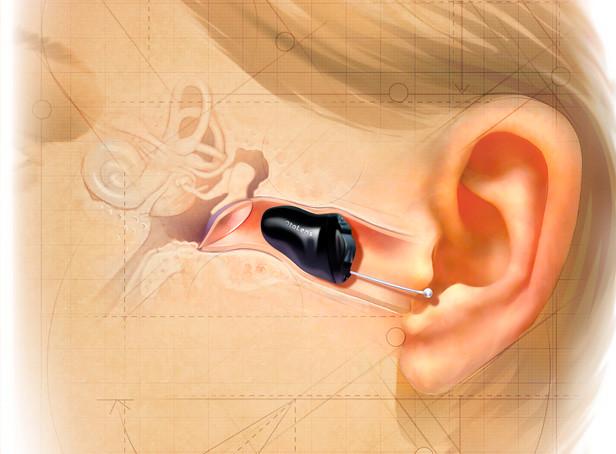Hearing loss affects millions of people worldwide, yet many hesitate to seek help due to concerns about how hearing aids might look. Modern hearing technology has evolved dramatically, with Invisible Hearing Aids (IIC) now offering an effective solution that addresses both hearing needs and aesthetic concerns. These tiny devices sit completely hidden within the ear canal, providing improved hearing without anyone knowing you’re wearing them.

Understanding Invisible-In-Canal Hearing Aids
Invisible-In-Canal hearing aids are the smallest hearing devices available today. Custom-made to fit the unique shape of your ear canal, these tiny technological marvels sit deep within the ear, making them virtually undetectable to others. Their placement takes advantage of the ear’s natural sound-gathering design, allowing for more natural sound quality while remaining completely hidden from view.
Unlike larger hearing aids that sit behind the ear or in the outer portion of the ear canal, IICs are inserted much deeper. This placement not only makes them invisible but also provides acoustic benefits. The natural shape of the ear helps direct sound into the device, creating a more natural listening experience compared to some other hearing aid styles.
Benefits of Invisible Hearing Technology
The most obvious advantage of IIC devices is their invisibility. For many people with hearing loss, concerns about appearance and stigma prevent them from seeking help. IIC technology eliminates this barrier, allowing users to improve their hearing without self-consciousness about wearing a visible device.
Another significant benefit is sound quality. Because these devices sit deep in the ear canal, they can take advantage of the ear’s natural anatomy to capture sound. This placement often results in reduced wind noise and better directional hearing, creating a more natural listening experience.
IIC devices are also protected from many common hearing aid problems. Their deep placement shields them from wind noise that can affect microphones in larger devices. Their position inside the ear also means they won’t interfere with phones, hats, or glasses like some behind-the-ear models might.
Hear Expert professionals often highlight the psychological benefits of invisible hearing technology. Many users report feeling more confident and less self-conscious when wearing these discreet devices, leading to improved social interactions and quality of life.

Who Can Benefit from IIC Hearing Aids
While invisible hearing aids offer many advantages, they aren’t suitable for everyone. These devices work best for people with mild to moderate hearing loss. Those with severe hearing loss typically require larger devices with more powerful components that can’t fit into the tiny IIC format.
Ear canal size and shape also determine candidacy. Since these devices sit deep within the ear canal, people with very narrow or irregularly shaped ear canals might not be able to wear them comfortably. A hearing professional can examine your ear canal and determine if you’re a good candidate.
The Fitting Process
Getting fitted for invisible hearing aids involves several steps to ensure optimal performance and comfort. The process begins with a comprehensive hearing evaluation to determine the type and degree of hearing loss. This assessment helps audiologists program the devices to address your specific hearing needs.
Next comes the ear impression, where the audiologist creates a mold of your ear canal. This step is crucial because IIC devices must fit perfectly to work properly and remain comfortable. The impression captures the exact shape and dimensions of your ear canal, allowing for a custom-made device.
After your custom devices are manufactured, you’ll return for a fitting appointment. The audiologist will insert the devices, make programming adjustments, and teach you how to insert, remove, and care for your new hearing aids. This training is essential since proper insertion affects both comfort and performance.
Also check out IIC Hearing Aids and Active Lifestyles: What You Need to Know
Caring for Your Invisible Hearing Aids
Proper maintenance is essential for keeping IIC devices working their best. Since these devices sit in the ear canal, they’re exposed to earwax and moisture, which can affect performance if not managed properly.
Daily cleaning is necessary to remove earwax and debris. Most devices come with special cleaning tools designed to safely remove buildup without damaging delicate components. It’s important to keep the sound port (where sound enters the device) clear of wax to maintain optimal sound quality.
Moisture protection is also crucial. Even though these devices are inside the ear, they can be affected by sweat and humidity. Many users keep their aids in dehumidifying containers when not in use to protect against moisture damage.
Battery management requires attention due to the small size of these devices. IIC hearing aids typically use very small batteries with shorter lifespans than larger devices. Having a system for tracking battery life and keeping spares on hand prevents unexpected power loss.
Limitations and Considerations
While invisible hearing technology offers many benefits, it’s important to understand its limitations. These devices have shorter battery life than larger hearing aids due to their small size. Most use tiny size 10 batteries that typically last 3-7 days, requiring more frequent changes than larger devices.
Advanced features may be limited in some IIC models. The small size restricts space for additional technology like Bluetooth connectivity or multiple microphones. However, technology continues to advance, and newer models offer more features than ever before.
Residents of Hearing Aids In Rajnandgaon and surrounding areas can consult with local hearing professionals to determine if these limitations would affect their specific needs and lifestyle.
Cost and Value Considerations
Invisible hearing technology typically comes at a premium price compared to larger, more visible options. The custom manufacturing process, miniaturized components, and advanced technology contribute to higher costs. However, many users find the benefits of invisibility and natural sound quality worth the investment.
Insurance coverage for hearing aids varies widely. Some health insurance plans provide partial coverage, while others offer no benefits for hearing devices. Medicare typically doesn’t cover hearing aids, though some Medicare Advantage plans might offer some coverage. It’s important to check your specific insurance benefits before making a decision.
When considering value, think beyond the initial price. Factor in the device’s expected lifespan (typically 5-7 years), the impact on your quality of life, and potential professional benefits from improved communication.
Future of Invisible Hearing Technology
Hearing technology continues to advance rapidly, with invisible devices benefiting from ongoing research and development. Future IIC devices will likely offer improved battery life, either through more efficient components or rechargeable options that eliminate the need for tiny disposable batteries.
Connectivity is another area of advancement. Despite their small size, newer invisible hearing aids are beginning to offer wireless features that allow them to connect to smartphones and other devices, expanding their functionality beyond simple sound amplification.
Artificial intelligence is revolutionizing hearing technology by allowing devices to learn user preferences and automatically adjust to different environments. This adaptive technology will continue to improve, making hearing aids more intuitive and effective in various listening situations.
Conclusion
Invisible-In-Canal hearing technology represents a remarkable advancement in addressing hearing loss without compromising aesthetics or comfort.
If you’re considering hearing aids and concerned about appearance, consulting with a hearing professional about IIC options could open the door to better hearing without the self-consciousness that sometimes accompanies traditional devices. With proper care and realistic expectations, these tiny marvels can significantly improve your hearing experience and quality of life.

